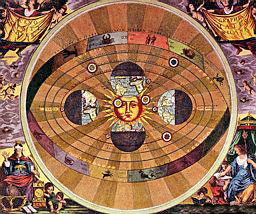|
Chapter Seven
A STONEHENGE ON
THE EUPHRATES
"There is a wealth of information in the inscriptions of
Gudea; the
more we study them and the special features of the Eninnu he built,
the more astounded we shall be.
"....Let us begin with the first task
Gudea undertook after the
construction of the ziggurat was completed and the temple-terrace
formed. It was the erection of seven upright stone pillars at seven
carefully selected positions. Gudea, the inscription states, made
sure that they be firmly erected: he "laid them on a foundation, on
bases he erected them."
"....Gudea spent a full year in bringing the rough stone blocks,
from which the uprights were carved to shape, from a distant source
to Lagash; and another year to cut and shape them. But then, in a
frenzied effort that lasted a precise seven days during which the
work was carried out without stopping, without rest, the seven stelae (as scholars call these upright stones) were set up in their
proper places. If, as the information given suggests, the seven stelae were positioned in some astronomical alignment, then the
speed becomes understandable, for the longer the setting up would
have taken, the more misaligned the celestial bodies would have
become.
"....Gudea gave each one a "name" made up of a long sacred utterance
evidently related to the position of the stela (e.g. "on the lofty
terrace," facing the "gate of the river bank" or another one
"opposite the shrine of Anu"). Although the inscription stated
unequivocally (column XXIX line 1) that "seven stelae were erected"
in those seven hectic days, the names of only six locations are
given. In respect to one, presumably the seventh stela, the
inscription states that it "was erected toward the rising sun."
Since by then all the required orientations of the Eninnu had
already been fixed, starting with the divine instructions and the
laying of the cornerstone by Ningishzidda, neither the six spread
out stelae nor the seventh "erected toward the rising sun" were
required for orienting the temple. Another, different purpose had to
be the motive, the only logical conclusion is that it involved
observations other than determining the Day of the Equinox (i.e. of
the New Year) - some astronomical-calendrical observations of an
unusual nature, justifying the great effort in obtaining and shaping
the stelae and the haste in setting them up.
|
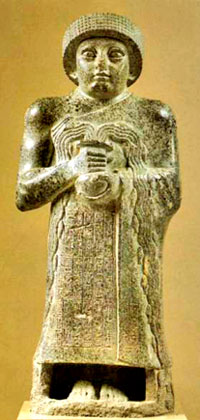
Gudea |
"The enigma of this erected stone pillars begins with the question,
why so many when two are enough to create a line of sight, say
toward the rising Sun. The puzzle is engulfed by incredulity when we
read on in the inscription the sensational statement that the sixth
whose locations were named were placed by Gudea "in a circle." Did
Gudea use the stelae to form a stone henge - in ancient Sumer, more
than five thousand years ago?
"Gudeaís inscription indicates, according to
A. Falkenstein (Die
Inschriften Gudeas von Lagash), the existence of an avenue or
pathway which - as at Stonehenge! - could provide an unimpeded
sightline. He noted that the stela which was "toward the rising sun"
stood at one end of a pathway or avenue called "Way to the high
position." At the other end of this was the Shugalam, the "High
place whose awesomeness is great, where the Brilliance is raised."
The term SHU.GALAM meant according to Falkenstein, "Where the hand
is raised" - a high place from which a signal is given. Indeed, the
Cylinder A inscription asserts that "At the radiant entrance of
Shugalam, Gudea stationed a favorable image; toward the rising Sun,
in the destined place, the emblem of the Sun he established."
"We have already discussed the functions of the Shugalam when
Gudea
had gone to it, in the old temple, to remove the mortar or mud that
obstructed the view through it. It was, we found, "the place of the
aperture, the place of determining." There, the inscription stated,
"Ninurta could see the repetitions" - the annual celestial cycle -
"over his lands."
"....At the Shugalam,
Gudea wrote, he "fixed the image of the Sun."
All the evidence suggests that it was a viewing device through which
the rising Sun - undoubtedly on Equinox Day, to judge from all the
data in the inscriptions was observed to determine and announce the
arrival of the New Year.
"Was the concept underlying the structural arrangement the same as
(possibly) the one at Mount Zaphon (Baíalís) and (certainly) as the
Egyptian temples, where a beam of sunlight passed along the
preselected axis to light up the Holy of Holies at sunrise on the
prescribed day?
"In Egypt the Sun Temples were flanked by
two obelisks which the
pharaohs erected so that they might be granted long life; their
function was to guide the Sunís beam on the prescribed day.
"....Scholars have noted that
Solomonís Temple also had two pillars
erected at its entrance; like the uprights at Eninnu which were
given names by Gudea, so were the two pillars named by
Solomon:
And he set up the pillars
in the porch of the temple.
He set up the right pillar
and called the name thereof Yakhin;
and he set up the left pillar
and called the name thereof Boíaz.
"....The two pillars were made of
cast bronze, eighteen cubits (some
twenty-seven feet) high. Each pillar supported a complex "headband"
around which, as a crown, there was placed a corolla whose serrated
top created seven protrusions; one of them (or both, depending on
the way the verse is read) was "encircled by a cord twelve cubits
long." (Twelve and seven are the predominant numbers in the Temple).
"The Bible does not state the purpose of these pillars, and theories
have ranged from purely decorative or symbolic to a function akin to
that of the pair of obelisks that flanked the entrances to the
temples in Egypt. In this regard a clue is suggested by the Egyptian
word for "obelisk," which was Tekhen. The term,
Budge ( E.A. Wallis
Budge) wrote, "was a very old word, and we find it in the dual in
the
Pyramid Texts which were written before the close of the VIth
Dynasty...." "The exact meaning Tekhen is unknown to us and it is
probable that the Egyptians had forgotten it at a very early
period." This raises the possibility that the word was a foreign
term, a "loanword" from another language or country, and we on our
part believe that the source, of both the biblical Yakhin and the
Egyptian Tekhen was the Akkadian root khunnu which meant "to
establish correctly" as well as "to start a light" (or fire). The Akkadian term may even be traced back to the earlier Sumerian term
GUNNU which combined the meanings "daylight" with "tube, pipe."
"These linguistic clues sit well with earlier Sumerian depictions of
temple entrances showing them flanked by pillars to which
circular
devices were attached.
"....The search for answers to the puzzle of these uprights is
further assisted by examining the term used by Gudea in his
inscriptions to describe the stone uprights. He called all seven of
them NE.RU - from which the Hebrew word Ner, meaning "candle,"
stems.
"....Such paired pillars, guiding (actually or symbolically) the
Sunís beam on a specific day were sufficient if only one solar
position - equinoctial or solstitial - was involved. If such a
single determination was intended at the Girsu, two stelae, in
alignment with the Shugalam, would have sufficed. But
Gudea set up
seven of them, six in a circle and the seventh in alignment with the
Sun. To form a line of sight, this odd pillar could have been
positioned either in the circleís center, or outside of it in the
avenue. Either way, the outcome would indicate uncanny similarities
to Stonehenge in the British Isles.
|
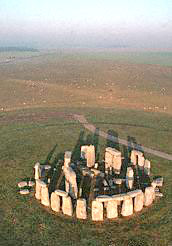 |
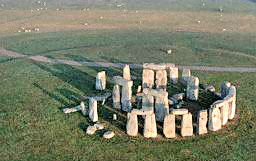
Stonehenge
in the British Isles. |
"Six outer or
circumference points with one in the center would have created a
layout that, as in Stonehenge II - belonging to the same time -
provided alignments not only with the equinoxes but also with the
four solstice points (midsummer sunrise and sunset, midwinter
sunrise and sunset). Since the Mesopotamian New Year was firmly
anchored to the equinoxes, resulting in ziggurats whose determining
corner was oriented to the east, an arrangement of stone pillars
that incorporated fixings of the solstices was a major innovation. It
also indicated a decisive "Egyptian" influence, for it was at
Egyptian temples that an orientation linked to the solstices was the
dominant feature - certainly by Gudeaís time.
|
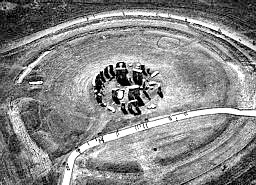
STONEHENGE # 2
|
"If, as Falkensteinís
study suggests, the seventh pillar was not within the circle of six
stelae but outside of it - in the pathway or avenue leading to the
Shugalam, an even more astounding similarity emerges, not to the
later Stonehenge, but to the earliest one, to Stonehenge I, where -
we may recall - there were only seven stones: the Four Station
Stones forming a rectangle, two Gateway Stones that flanked the
beginning of the Avenue, and the Heel Stone that marked out the
sightline - an arrangement of seven stone uprights.
"....Such a similarity in layouts would be even more significant
than the first alternative, for - as we have reported earlier - the
rectangle formed by the four Station Stones implied lunar
observations in addition to the solar ones. The realization of this
arrangement led both Newham and Howkins to far-reaching conclusions
regarding the sophistication of the planners of Stonehenge I. But
since Stonehenge preceded the Eninnu by about seven centuries the
similarity would have to imply that whoever had planned the layout
of the seven uprights in the Eninnu copied from whoever had planned
Stonehenge I.
"Such a kingship between the two structures, in two different parts
of the world, seems incredible; it will, however, become credible as
we bring to light more amazing aspects of Gudeaís Eninnu.
"The six-plus-one circle just described was not the only stone
circle on the platform of the new Eninnu.
"Boasting that he accomplished "great things" that called for
unusual "wisdom" (scientific knowledge)
Gudea proceeded to describe,
after the section dealing with the stelae, the "crownlike circle for
the new Moon" - a creation in stone so unique that "its name in the
midst of the world he caused to brightly go forth." This second
circle was arranged as a "round crown for the new Moon" and
consisted of thirteen stones erected "like heroes in a net-work" - a
most figurative way, it seems to us, to describe a circle of upright
stones connected at the top by lintels to form a "network" akin to
the Trilithons at Stonehenge!
"While the possibility that the first smaller circle served lunar as
well as solar functions can be only surmised, the second larger
circle was undoubtedly intended to observe the Moon. Judging by the
repeated references in the inscriptions of the New Moon, the lunar
observation was geared to the Moonís monthly cycle, its waxing and
waning in the course of four quarters. Our interpretation of the
crownlike circle is reinforced by the statement that this circle
consisted of two groups of megaliths - one of six and the other of
seven, with the latter apparently more elevated or taller than the
first.
"At first glance the arrangement of thirteen (six plus seven)
megaliths, connected at their tops by lintels to form a "crown,"
seems to be an error, because we expect to find only twelve pillars
(which in a circle create twelve apertures) if the arrangement is
related to the twelve months of the lunar phases. The presence of
thirteen pillars, however, does make sense if account were taken of
the need to add one month every now and then for intercalation
purposes. If so, the amazing stone circles in the Girsu were also
the first instance when calendars made of stone meshed to correlate
the solar and lunar cycles.
|
 |
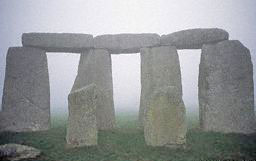
TRILITHONS
|
"(One wonders whether
these stone circles in the Girsu somehow presaged the introduction
of the seven-day week - a division of time whose origin has evaded
scholars - the biblical week which totaled seven by adding the six
days of creation to the final additional day of rest. The number
seven appears twice, in the first arrangement of pillars and as part
of the second circle; and it is quite possible that somehow days
were according to either group, leading to a repetition of periods
of seven days. Also, four phases of the Moon multiplied by the
thirteen pillars would divide the year into fifty-two weeks of seven
days each).
"Whatever the astronomical-calendrical possibilities inherent in the
two circles ( and we have probably only touched upon the very basic
ones), it is evident that in the Girsu of Lagash a solar-lunar stone
computer was put in operation.
"If all this begins to sound like a "Stonehenge on the Euphrates" -
a mini-Stonehenge erected by a Sumerian king in the Girsu of Lagash
at about the same time that Stonehenge in the British Isles became a
truly stone circle circa 2100 B.C. - there is more to come. It was
at that time the second type of stone, the bluestones, was brought
to the plain of Salisbury from a distant source.
|
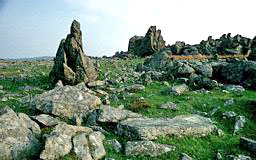
Preseli
Bluestone (spotted dolerite). Stones used at Stonehenge,
from the quarry of Carn Meini, Wales. |
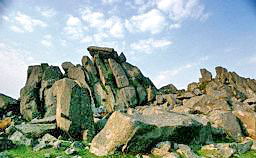
|
"This too enhances the
similarities: Gudea too hauled not one but two types of stones from
a great distance, "from the stone mountains" of Magan (Egypt) and
Melukhah (Nubia), both in Africa....To reach them,
Gudea "into the
mountains made a way, and their great stones he brought out in
blocks; shiploads of Hua stones and Lua stones."
"....As at
Salisbury Plain in the British Isles so was it in the
Mesopotamian plain: stones hauled from afar, stones especially
selected, set up in two circles. As at Stonehenge I, seven pillars
played a key role; as in all the phases of Stonehenge in Lagash too,
a large megalith created the desired sightline toward the principal
solar orientation. In both places a stone "computer" was created to
serve as a solar-lunar observatory.
"Were both, then, created by the same scientific genius, by the same
Divine Architect - or were they simply the result of accumulated
scientific traditions that found expression in similar structures?
"....In earlier chapters we have pointed out the key difference in
design between Stonehenge and all the other temples of the
Old
World: the former was based on circular formations to observe the
heavens; the latter were all built with right angles (rectangular or
square). This difference is evident not only in the general plan of
the other temples but also in the several instances where stone
uprights were found, emplaced in a pattern suggesting an
astronomical-calendrical function. An outstanding example was found
at Byblos, on a promontory overlooking the Mediterranean Sea. The
Holy of Holies of its temple, square in shape, was flanked by
upright stone monoliths. They were set up in alignments suggesting
observations of equinoxes and solstices, but none were arranged in a
circle. So apparently was the case at a Canaanite site,
Gezer, near
Jerusalem, where the discovery of a tablet inscribed with the full
list of months and their agricultural activities may suggest the
existence of a center for the study of the calendar. There too a row
of upright monoliths indicates the existence in antiquity of a
structure perhaps akin to that of Byblos....
|
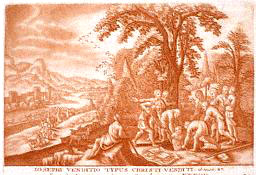
JOSEPH SOLD....
|
"....The few known
instances of monoliths arranged in a circle, somehow emulating the
extraordinary circular arrangement at the Girsu, come to us from the
Bible. Their rarity, however, points to a direct connection to
Sumer
in Gudeaís time.
"Knowledge of a circle of thirteen with an upright in the center
emerges in the tale of Joseph, a great-grandson of Abraham....
Joseph related (a dream), he saw "the Sun and the Moon and eleven
stars bowing down to me," meaning his father and mother and eleven
brothers.... (this dream led his brothers to sell him into slavery
in Egypt)....
"Several centuries later, as the Israelites left
Egypt for the
Promised Land in Canaan, an actual stone circle - this time of
twelve stones - was erected.
Mr. Sitchin relates here the event of
Joshua (recorded in the Bible,
chapters 3 and 4 of the Book of Joshua), when he crossed the Jordan
river leading the twelve tribes of Israel, where instructed by
Yahweh, the heads of the twelve tribes erected twelve stones in the
midst of the river, enabling them to cross carrying the Ark of the
Covenant. After the crossing they were ordered to take the twelve
stones and erect them in a circle as an everlasting commemoration of
the miracle of the crossing.... The place is know as Gilgal, meaning
"Place of the Circle."
"Not only the establishment of the
twelve stones circle as a
miraculous device is relevant here; so is the date of the event. We
first learn in chapter 3 that the time was "harvest time, when the
waters of the Jordan overflow its banks." Then chapter 4 is more
specific: it was in the first month of the calendar, the month of
the New Year, and it was on the tenth of that month - the very day
on which the inauguration ceremonies were culminated in Lagash -
that "the people left the Jordan and encamped at Gilgal, where
Joshua erected the twelve stones brought up from the Jordan River."
"....The emergence of
traditions of stone circles among the descendants of Abraham can be
traced, we believe, to Abraham himself and the identity of his
father Terah.... was an astronomer-priest in Nippur when
Enlil
authorized his son, Ninurta, to proceed with the building of the new
Eninnu by Gudea....
Abraham.... was well-versed in royal and priestly matters, including
astronomy. Getting his education in the sacred precincts of Nippur
and Ur just as the glories of the new Eninnu were talked about, he
could not have missed learning of the wondrous stone circle of the Girsu; and this would explain the knowledge thereof by his
descendants.
"Where did the
idea of a
circle as a shape appropriated to astronomical observations - a
shape that is the most outstanding feature of Stonehenge - come
from? In our view, it came from the zodiac, the cycle of twelve
constellations grouped around the Sun in the orbital plane (the
Ecliptic) of the planets.
"Earlier this century archaeologists uncovered in
the Galilee, in
northern Israel, the remains of synagogues dating to the decades and
centuries immediately following the destruction of the Second Temple
in Jerusalem by the Romans (in A.D. 70). To their surprise, a common
feature of those synagogues, was the decoration of their floors with
intricate mosaic designs that included the design of the zodiac.
|
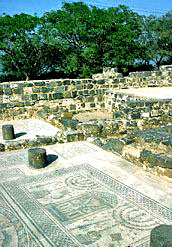
|
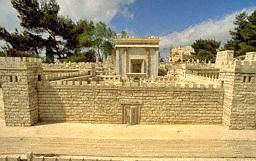
Model of
Second Temple, above; Floor Mosaic on ruins of
Synagogue, Galilee, left. (On Mr. Sitchinís book the
mosaic of a Floor Zodiac is shown). |
"....From a place called
Bet-Alpha (a floor mosaic) shows the number twelve - was the same as
nowadays, the symbols were the same as now in use, and so were the
names: written in a script no different from that of modern
Hebrew.... and so in the very same order that we continue to employ
millennia later.
"This zodiacal circle of what the Akkadians called
Manzallu
("stations" of the Sun) was source of the Hebrew term
Mazalot, which
came to denote "lucks." Therein lies the transition from the
essential astronomical and calendrical nature of the zodiac to its
astrological connotations - a transition that in time obscured the
original significance of the zodiac and the role it played in the
affairs of gods and men. Last but not least was its wondrous
expression in the Eninnu that Gudea built.
"The notion has prevailed, in spite of the facts, that the concept,
names, and symbols of the zodiac were devised by the Greeks, for the
word is of Greek origin, meaning "animal circle." It is conceded
that the inspiration for them may have come from Egypt, where the
zodiac with its unaltered symbols, order, and names was certainly
known.... the zodiac did not begin there. Studies such as the one by
E.C. Krupp (In Search of Ancient Astronomies) have emphatically
stated that "all available evidence indicates that the concept of
the zodiac was not native to Egypt; instead, it is believed that the
zodiac was imported to Egypt from Mesopotamia," at some unknown
date.... Greek savants.... have attested that as far as astronomy
was concerned, its knowledge came to them from the "Chaldeans," the
astronomer-priests of Babylonia.
"....The zodiac, however, was begun, as far as Mankind is concern,
in Sumer.... (as it is shown in the first book
The 12th Planet).
"....Overwhelming evidence demonstrates that the Sumerians were
cognizant of the zodiacal ages - not only the names and images but
the precessional cycle thereof - when the calendar was begun in
Nippur, circa 3800 B.C., in the Age of Taurus.
Willy Hartner, in his
study titled "The Earliest History of the Constellations in the Near
East" (Journal of Near Eastern Studies), analyzed the Sumerian
pictorial evidence and concluded that numerous depictions of a bull
nudging a lion (from the fourth millennium B.C.), or a lion pushing
bulls (from about 3000 B.C.) are representations of the zodiacal
time when the spring equinox, at which time the calendrical new year
began, was in the constellation Taurus and the summer solstice
occurred in the sign of Leo.
|
 |
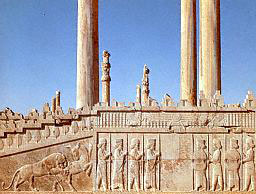
The Apadana,
Persepolis, where a depiction of a Lion fighting a Bull
are shown. |
"Alfred Jeremias (The
Old Testament in the Light of the Ancient Near East) found textual
evidence that the Sumerial zodiacal-calendrical "point zero" stood
precisely between the Bull and the Twins (Gemini), from which he
concluded that the zodiacal division of the heavens - inexplicably
to him - was devised even before the Sumerian civilization began, in
the Age of Gemini. Even more puzzling to scholars has been a
Sumerian astronomical tablet (VAT.7847 in the Berlin Vorderasiatisches Museum) that begins the list of zodiacal
constellations with that of Leo - taking one back to circa 11000
B.C., just about the time of the Deluge.
"Devised by
the Anunnaki as a link between Divine Time (the
cycle
based on the 3,600 years orbit of Nibiru) and
Earthly Time (the
Earthís orbital period), the Celestial Time (the
time span of 2,160
years for precessional shift from zodiacal House to another) served
to date major events in Earthís prehistory as archaeoastronomy could
do in historical times. Thus, a depiction of the Anunnaki as
astronauts and a spacecraft coursing between
Mars (the six pointed
star) and Earth (identified by the seven dots and the accompanying
crescent of the Moon) places the event, time wise, in the Age of
Pisces by including the zodiacal symbol of the two fishes in the
depiction.
Written texts also included zodiacal dates; a text placing the
Deluge in the Age of Leo is one example.
"....It should not surprise us to discover that zodiacal depictions
were indeed present in the new temple in Lagash;
not however, on the
floor as in Bet-Alpha, and not as symbols carved on boundary stones.
Rather, in a magnificent structure that can rightly be called the
first and most ancient planetarium!
"....But we could have gone to
Denderah, in Upper Egypt, enter there
the inner sanctum of its principal temple, and looked up to the
ceiling. there we could have seen a painting of the starry heavens:
the celestial circle, held up at the four cardinal points by the
sons of Horus and at the four points of solstitial sunrise and
sunset by four maidens. A circle depicting the six "decans" (ten day
periods, three per month, of the Egyptian calendar) surrounds the
central "vault of heaven" in which the twelve zodiacal
constellations are depicted by the same symbols (bull, ram, lion,
twins, etc.) and in the same order that we still use and that was
begun in Sumer....
"....Scholars are unable to agree on the point in time represented
in the Denderah zodiac.... Scholars are, however, certain that it
replicated a similar depiction in a much earlier temple, one that
was dedicated to the goddess Hathor. Sir Norman Lockyer in the
Dawn
of Astronomy interpreted a Fourth Dynasty (2613 - 2494 B.C.) text as
describing the celestial alignments in that earlier temple; this
would date the Denderah "vault of heaven" to a time between the
completion of Stonehenge I and the building of the Eninnu in Lagash
by Gudea....
|
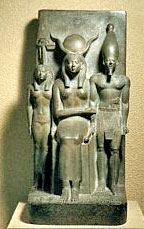
Goddess
Hathor, in the Fourth Dynasty |
|
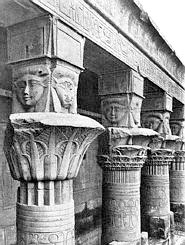
|
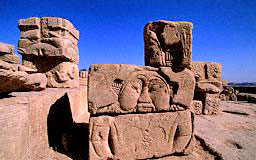
Some views
of Hathorís Temple |
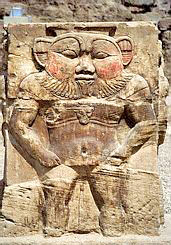 |
"....According to the
Egyptian chronology transmitted by the priests and recorded by
Manetho, that was the time when demigods reigned over
Egypt; such
dating of the Denderah skies (as distinct from when the temple
itself was built) corroborates the findings, mentioned above (plus
more, of which Mr. Sitchin gives details in his actual book) by
Alfred Jeremias regarding the "point zero" of the Sumerian zodiacal
calendar. Both Egyptian and Sumerian datings thus confirm that the
concept preceded the star of those civilizations, and that the
"gods," not men, were responsible for the depictions and their
dating.
"Since, as we have shown, the zodiac and its accompanying
Celestial
Time were devised by the Anunnaki soon after they came to Earth,
some of the zodiacal dates marking events depicted on cylinder seals
do stand for zodiacal ages that preceded the emergence of Manís
civilizations.
"....Incredibly but not surprisingly, we find a suggestion that a
"starry heaven" depicting the celestial circle with the
constellations of the zodiac might have existed in the earliest
times in a Sumerian text known to scholars as a Hymn to Enlil the
All-Beneficent. Describing the innermost part of Enlilís
Mission
Control Center in Nippur, inside the E.KUR ziggurat, the text states
that in a darkened chamber called Dirga there was installed "a
heavenly zenith, as mysterious as the distant sea" in which "the
starry emblems" were "carried to perfection."
"The term
DIR.GA connotes "dark, crownlike"; the text explains that
the "starry emblems" installed therein enabled the determination of
festivals, meaning a calendrical function. It all sounds like a
forerunner of Gudeaís planetarium; except that the one in
the Ekur
was hidden from human eyes, open to the Anunnaki alone.
|
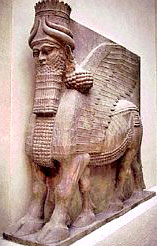 |
"....Some of the most
impressive finds now adorning the Assyrian and Babylonian
collections in the major museums are colossal stone animals with
bodies of bulls or lions and heads of gods wearing horned caps that
stood as guardians at temple entrances. We can safely assume that
these "mythical creatures," as scholars call them, translated into
stone sculptures the Bull-Lion motif that we illustrated earlier,
thereby invoking for the temples the magic of an earlier Celestial
Time and the gods associated with its past zodiacal ages.
"Archaeologists believe that these sculptures were inspired by the
sphinxes of Egypt, primarily the Great Sphinx of Giza, with which
the Assyrians and Babylonians were familiar as a result of both
trade and warfare. But the Gudea inscriptions reveal that some
fifteen hundred years before such zodiacal-cum-divine creatures were
emplaced in Assyrian temples, Gudea had already positioned sphinxes
at the Eninnu temple; the inscriptions specifically mention "a lion
that instilled terror" and a "wild ox, massively crouching like a
lion." To the archaeologistsí utter disbelief that sphinxes could
have been known in Sumer, a statue of Ninurta/Ningirsu himself,
depicting him as a crouching sphinx, was discovered among the ruins
of the Girsu in Lagash.
One of the assertions given to
Gudea, by Ninurta, was "As a strong
place it shall be built, like E.HUSH will my holy place be."
"This last statement is truly sensational in its implications.
""E" as we already know meant a godís house," a temple; and in the
case of the Eninnu - a stage-pyramid. HUSH (pronounced "Chush" with
the "ch" as in the German Loch) meant in Sumerian "of reddish hue,
red-coloured." So this is what Ninurta/Ningirsu stated:
the new Eninnu will be like the "Red-hued Divine House." The statement
implies that the new Eninnu will emulate an existing structure known
for its reddish hue. . .
"Our search for such a structure can be facilitated by tracking back
the pictograph for the sign Hush. What we find is really astounding,
for what it amounts to is a line drawing of an Egyptian pyramid
showing its shafts, internal passages, and subterranean chambers.
More specifically, it appears to be drawn as a cross section of the
Great Pyramid of Giza and its trial scale model, the small pyramid
of Giza - and of the first successful pharaonic pyramid which, quite
significantly - was called the Red Pyramid, of the very same hue
that Hush had meant.
"The Red Pyramid was certainly there to be emulated when
the Eninnu
was built in Lagash. It was one of three pyramids attributed to
Sneferu.... (circa 2600 B.C.).
"....Having fought (and won) the
Second Pyramid War in Egypt, Ninurta was not unfamiliar with the subsequent pyramids. Had he
seen, as kingship came from Egypt, not only the Great Pyramid and
its companions at Giza, but also the step-pyramid built by the
pharaoh Zoser at Sakkara, surrounded by its magnificent sacred
precinct, built circa 2650 B.C.? Had he seen the final successful
emulation by a pharaoh and his architects of the Great Pyramid - the
Red Pyramid of Sneferu....? And did he then tell the Divine
Architect: that is what I would have built for me, a unique ziggurat
combining elements of all three?
|
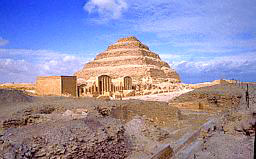
Pharaoh
Zoserís Pyramid at Sakkara. |
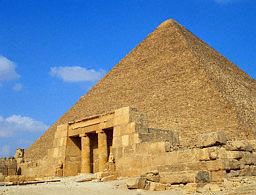
Great
Pyramid at Giza |
"Else, how can one
account for the compelling evidence linking the Eninnu, built
between 2200 and 2100 B.C., with Egypt - and its gods?
"And how else, except in this way, can one explain the similarities
between Stonehenge in the British Isles and Stonehenge on the
Euphrates?
"For the explanation we have to turn our attention to the
Divine
Architect, the Keeper of the Secrets of the Pyramids, the
god called
by Gudea Ningishzidda, for he was none other than the Egyptian god
Tehuti whom we call THOTH.
"Thoth was called in the
Pyramid Texts: "He who reckons the heavens,
the counter of the stars and the measurer of the Earth"; the
inventor of arts and sciences, scribe of the gods, the "One who made
calculations concerning the heaven, the stars and the Earth." As the
"Reckoner of times and of seasons," he was depicted with a symbol
combining the Sunís disk and the Moonís crescent upon his head, and
in words reminiscent of the biblical adoration of the Celestial Lord
- the Egyptian inscriptions and legends said of Thoth that his
knowledge an powers of calculating "measured out the heavens and
planned the Earth." His hieroglyph name Tehuti is usually explained
as meaning "He who balances."
....The Greeks identified
Thoth with their god Hermes, whom they
considered to have been the originator of astronomy and astrology,
of the science of numbers and of geometry, of medicine and botany.
|
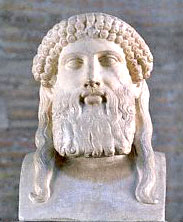
HERMES
|
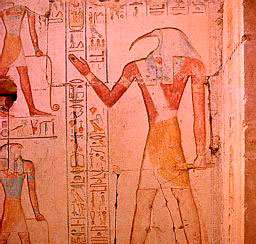
THOTH
|
"As we follow in the
footsteps of Thoth, we shall come upon calendar tales that rise the
curtain on the affairs of gods and men - and on enigmas such as
Stonehenge.
Return
Chapter Eight
CALENDAR TALES
"....The notion that
the calendar was devised by and for farmers so
that they would know when to sow and when to reap has been taken for
granted too long.... Farmers do not need a formal calendar to know
the seasons, and primitive societies have managed to feed themselves
for generations without a calendar. The historic fact is that the
calendar was devised in order to predetermine the precise time of
festivals honoring the gods. The calendar in other words was a
religious device. The first names by which months were called in
Sumer had the prefix EZEN. The word did not mean "month"; it meant
"festival." The months were the times when the Festival of
Enlil, or
the Festival of Ninurta, or those of the other leading deities were
to be observed.
"That the calendarís purpose was to enable religious observances
should not surprise one at all. We find an instance that still
regulates our lives in the current common, but actually, Christian,
calendar. Its principal festival and the focal point that determines
the rest of the annual calendar is Easter, the celebration of the
resurrection, according to the New Testament, of Jesus on the third
day after the crucifixion. Western Christians celebrate Easter on
the third Sunday after the full moon that occurs on or right after
the spring equinox. This created a problem for the early Christians
at Rome, where the dominant calendrical element was the
solar year
of 365 days and the months were of irregular length and not exactly
related to the Moonís phases. The determination of Easter Day
therefore required a reliance on the Jewish calendar, because the
Last Supper, from which the other crucial days of Eastertide are
counted, was actually the Seder meal with which the Jewish
celebration of Passover begins on the eve of the fourteenth day of
the month Nissan, the time of the full Moon.
|
 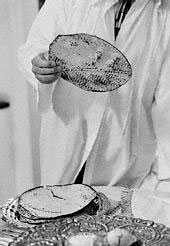 
Some aspects
of Jewish Traditional Seder Meal.Passover
|
|
 |
|
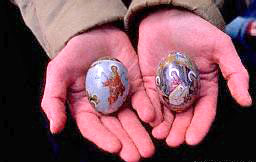
Expression
of New Life; Easter, in the Christian World.
|
 |
"As a result, during the
first centuries of Christianity Easter was celebrated in accordance
with the Jewish calendar. It was only when the Roman emperor
Constantine, having adopted Christianity, convened a church council,
the Council of Nicaea, in the year 325, that the continued
dependence on the Jewish
|
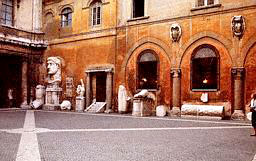
Ruined statue of
Roman Emperor Constantine, Rome |
calendar was severed,
and Christianity, until then deemed by the gentiles as merely
another Jewish sect, was made into a separate religion.
"....The current
Common
Era Christian-calendar was introduced by Pope Gregory XIII in 1582
and is therefore called the Gregorian Calendar. It constituted a
reform of the previous Julian Calendar, so named after the Roman
Emperor Julius Caesar.
"That noted Roman emperor, tired of the
chaotic Roman calendar,
invited in the first century B.C. the astronomer Sosigenes of
Alexandria, Egypt, to suggest a reform of the calendar. Sosigenesí
advice was to forget about lunar-time keeping and to adopt a solar
calendar "as that of the Egyptians." The result was a year of 365
days plus a leap year of 366 days once in four years.
|
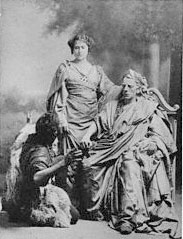
Julius
Caesar (1st century B.C.) |
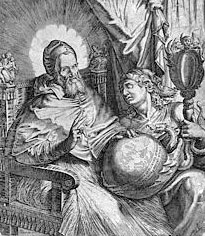
Pope Gregory
XIII (late 1500s) |
"But that still failed
to account for the extra 11 1/4 minutes a year in excess of the
quarter day and above the 365 days. That seemed too minute to bother
with; but the result was that by 1582 the first day of spring, fixed
by the Council of Nicaea to fall on March 21, was retarded by ten
days to March 11th. Pope Gregory corrected the shortfall by simply
decreeing on October 4, 1582, that the next day should be October
15. This reform established the currently used Gregorian calendar,
whose other innovation was to decree that the new year begin on
January first.
"....The Egyptians were aware that the solar year is somewhat longer
than 365 days - not just by the full day every four years, as Julius
Caesar had allowed for, but by enough to shift the calendar back by
one month every 120 years and by a full year every 1,460 years. The
determining or sacred cycle of the Egyptian calendar was this
1,460-year period, for it coincided with the cycle of the heliacal
rising of the star Sirius (Egyptian
Sept, Greek Sothis) at the time
of the Nileís annual flooding, which in turn takes place at about
the summer solstice (in the northern hemisphere).
"Edward Meyer (Agyptische Chronologie) concluded that when this
Egyptian calendar was introduced, such a convergence of the heliacal
rising of Sirius and of the Nileís inundation had occurred on July
19th. Based on that, Kurt Sethe (Urgeschichte und altested Religion
der Agypter) calculated that this could have happened in either
4240 B.C. or 2780 B.C. by observing the skies at either Heliopolis
or Memphis.
"By now researchers of the ancient Egyptian calendar agree that the
solar calendar of 360 + 5 days was not the first prehistoric
calendar of that land. This "civil" or secular calendar was
introduced only after the start of dynastic rule in Egypt, i.e.,
after 3100 B.C.; according to Richard A. Parker (The Calendar of the
Ancient Egyptians) it took place circa 2800 B.C. "probably for
administrative and fiscal purposes." This civil calendar supplanted,
or perhaps supplemented at first, the "sacred" calendar of old. In
the words of the Encyclopaedia Britannica, "the ancient Egyptians
originally employed a calendar based upon the Moon." According to
R.A. Parker (Ancient Egyptian Astronomy) that earlier calendar was,
"like that of all ancient peoples," a calendar of twelve lunar
months plus a thirteen intercalary month that kept the seasons in
place.
"That earlier calendar was also, in the opinion of
Locker,
equinoctial and linked indeed to the earliest temple at Heliopolis,
whose orientation was equinoctial. In all that, as in the
association of months with religious festivals, the earliest
Egyptian calendar was akin to that of the Sumerians.
"The conclusion that
the Egyptian calendar had its roots in predynastic times, before civilization appeared in
Egypt, can only
mean that it was not the Egyptians themselves who invented their
calendar. It is a conclusion that matches that regarding the zodiac
in Egypt, and regarding both the zodiac and the calendar in Sumer:
They were all the artful inventions of the "gods."
"....
Ra was the head of the first divine dynasty according to the
Egyptian priest Manetho.... The reign of Ra and his successors, the
gods Shu, Geb, Osiris, Seth and Horus, lasted more than three
millennia. It was followed by second divine dynasty that was begun
by Thoth, another son of Ptah; it lasted half as long as the first
dynasty. Thereafter a dynasty of demigods, thirty of them, reigned
over Egypt for 3,650 years. Altogether, according to Manetho, the
divine reigns of Ptah, the Ra dynasty, the Thoth dynasty and the
dynasty of the demigods lasted 17,520 years....
"....Based on
substantial evidence, we have concluded in
The Wars of
Gods and Men and other volumes of The Earth Chronicles that
Ptah was
none other than Enki and that Ra was Marduk on the Mesopotamian
pantheon. It was to Enki and his descendants that the African lands
were granted when the Earth was divided among the Anunnaki
after the
Deluge, leaving the E.DIN (the biblical land of Eden) and the
Mesopotamian sphere of influence in the lands of Enlil and his
descendants. Thoth, a brother of Ra/Marduk, was the god of the
Sumerians called Ningishzidda.
|

Sculpture at
Temple of Ptah |
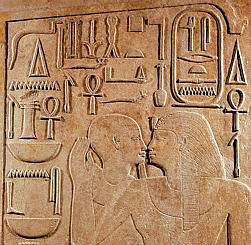
Sesostris I
and Ptah |
|
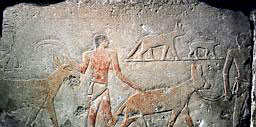
From the
Tomb of Ptah |
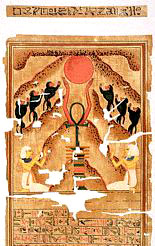
Adoration of
Ra |
"Much of the history and
violent conflicts that followed the Earthís division stemmed from
the refusal of Ra/Marduk to acquiesce in the division. He was
convinced that his father was unjustly deprived of lordship of Earth
(what the epithet-name EN.KI, "Lord Earth," connoted); and therefore
he and not Enlilís foremost son Ninurta, should rule supreme on
Earth from Babylon, the Mesopotamian city whose name meant "Gateway
of the Gods." Obsessed by his ambitions, Ra/Marduk caused not only
conflicts with the Enlilites, but also aroused the animosity of some
of his own brothers by involving them in these bitter conflicts as
well as by leaving Egypt and then returning to reclaim lordship over
it.
"In the course of these comings and goings and ups and downs in
Ra/Mardukís
struggles, he caused the death of a younger brother, Dumuzi, let his
brother Thoth reign and then forced him into exile, and made his
brother Nergal change sides in a War of the Gods that resulted in a
nuclear holocaust. It was in particular the on-again, off-again
relationship with Thoth, we believe, that is essential to the
Calendar tales.
"The Egyptians, it will be recalled, had not one but
two
calendars.... one, was "based upon the Moon." The
later one.... was
based on the 365 days of the solar year. Contrary to the notion that
the latter "civil calendar" was an administrative innovation of a
Pharaoh, we suggest that it too, like the earlier one, was an artful
creation of the gods; except that while the first one was the
handiwork of Thoth, the second one was the craftwork of Ra.
"One aspect of the civil calendar considered specific and original
to it was the division of the thirty-day months into "decans,"
ten-day periods each heralded by the heliacal rising of a certain
star. Each star (depicted as a celestial god sailing the skies), was
deemed to give notice of the last hour of the night; and at the end
of ten days, a dew decan-star would be observed.
"It is our suggestion that the introduction of this
decan-based
calendar was a deliberate act by Ra in a developing conflict with
his brother Thoth.
"....Was there, perhaps, some jealousy between the two brothers on
this score....? Marduk lacked the knowledge of medicine and healing,
his knowledge fell short of his brotherís: he could not revive the
dead, while Thoth could.... His Sumerian depictions show him with
the emblem of the entwined serpents, the emblem originally of his
father Enki as the god who could engage in genetic engineering - the
emblem, we have suggested, of the double helix of DNA.
|
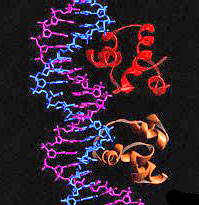
Cro Protein
Molecules Bound to DNA Helix |

Thoth |
"His Sumerian name,
NIN.GISH.ZID.DA, which meant "Lord of the Artifact of Life," bespoke
recognition of his capacity to restore life by reviving the dead....
He was prominently featured in magical healing and exorcism texts; a
Maklu ("Burnt Offerings") series of incantations and magical
formulas devoted a whole tablet, the seventh, to him. In one
incantation, devoted to drowned mariners ("the seafaring folk who
are utterly at rest"), the priest invokes the formulas of "Siris and
Ningishzidda, the miracle workers, the spellbinders").
"Siris is the name of a goddess otherwise unknown in the Sumerian
pantheon, and the possibility that it is a Mesopotamian rendition of
the starís name Sirius comes to our mind because in the Egyptian
pantheon Sirius was the star associated with the goddess Isis.
"....The Egyptians held that the whole
Book of the Dead, verses from
which were inscribed on the walls of pharaonic tombs so that the
deceased pharaoh could be translated into an Afterlife, was a
composition of Thoth, written with his own fingers." In a shorter
work called by the Egyptians the Book of Breathings, it was stated
that,
"Thoth, the most mighty god, the
lord of Khemennu, cometh to
thee, he writeth for thee the book of Breathings with his own
fingers, so that thy Ka shall breathe for ever and ever and thy form
endowed with life on Earth."
"We know from Sumerian sources that this knowledge, so essential in
pharaonic beliefs - knowledge to revive the dead - was first
possessed by Enki.
"....Evidently, the secret was not divulged to
Marduk; and when he
complained, his father gave him an evasive answer. That alone would
have been enough to make the ambitious and power-hungry Marduk
jealous of Thoth.... All that (and other events) led - as the
Sumerian text makes clear - to an affinity between Thoth and the
star Sirius, the controller of the Egyptian calendar and the
harbinger of the life-giving inundation of the Nile.
"Were these the only reason for the jealousy, or did
Ra/Marduk have
more compelling reasons to see in Thoth a rival, a threat to his
supremacy?
"....Why was it Thoth, of all the other sons of
Ptah/Enki who was
chosen to replace the dynasty of Ra in Egypt?
"....It is known that initially the dominating "company of the gods"
or divine dynasty was that of Heliopolis; later on was superseded by
the divine triad of Memphis (when Memphis became the capital of a
unified Egypt). But in between there was an interim Paut or "divine
company" of gods headed by Thoth. The "cult center" of the latter
was Hermopolis ("City of Hermes" in Greek) whose Egyptian name,
Khemennu, meant "eight." One of the epithets of
Thoth was "Lord of
Eight," which according to Heinrich Brugch (Religion and Mythologie
der alien Aegypter) referred to eight celestial orientations,
including the four cardinal points. It could also refer to Thothís
ability to ascertain and mark out the eight standstill points of the
Moon - the celestial body with which Thoth was associated.
"Marduk, a "Sun god," on the other hand, was associated with the
number ten. In the numerical hierarchy of the Anunnaki, in which
Anuís rank was the highest.... the rank of Marduk was ten, and that
could have been the origin of the decans. Indeed the Babylonian
version of the Epic of Creation, attributes to Marduk the
devising
of a calendar of twelve months each divided into three "celestial
astrals":
He determined the year,
designating the zones:
For each of the twelve months
he set three celestial astrals,
[thus] defining the days of the year.
"This division of the skies into thirty-six portions as a means of
"defining the days of the year" is as clear a reference as possible
to the calendar - a calendar with thirty-six "decans." And there in
Enuma Elish, the division is attributed to
Marduk, alias Ra.
"....Without further discovery of intact or even fragmented tablets
inscribed with the original Sumerian text of the Epic of Creation,
it is impossible to say whether the thirty-six decans were a true
innovation by Marduk or were just borrowed by him from Sumer. A
basic tenet of Sumerian astronomy was the division of the celestial
sphere enveloping the earth into three "ways" - the Way of Anu as a
central celestial band, the Way of Enlil of the northern skies, and
the Way of Ea (i.e., Enki) in the southern skies. It has been
thought that the three ways represented the equatorial band in the
center and the bands demarcated by the two tropics, north and south;
we have, however, shown in
The 12th Planet that the
Way of Anu,
straddling the equator, extended 30ļ northward and southward of the
equator, resulting in a width of 60ļ; and the Way of Enlil and the
Way of Ea similarly extended for 60ļ each, so that the three covered
the complete celestial sweep of 180ļ from north to south.
"If this tripartite division of the skies were to be applied to the
calendrical division of the year into twelve months, the result
would be thirty-six segments. Such a division - resulting in decans
- was indeed made in Babylon.
"While this
Babylonian planisphere does not answer the question of
the origin of the relevant verses of the Enuma Elish, it does
establish that what it was supposed to have been a unique and
original Egyptian innovation in fact had a counterpart (if not a
predecessor) in Babylon - the place claimed by Marduk for his
supremacy.
"....The fact is that when the time came, circa 3100 B.C., to
extend
the Sumerian level of civilization (human Kingship)
to the
Egyptians, Ra/Marduk - having been frustrated in his efforts to
establish supremacy in Babylon - returned to Egypt and expelled
Thoth.
"It was then, we believe, that Ra/Marduk - not for administrative
convenience but in a deliberate step to eradicate the vestiges of
Thothís predominance - reformed the calendar. A passage in the
Book
of the Dead relates that Thoth was "disturbed by what hath happened
to the divine children" who have "done battle, upheld strife,
created fiends, caused trouble." As a consequence of this Thoth "was
provoked to anger when they [his adversaries] bring the years to
confusion, throng in and push to disturb the months." All that evil,
the text declares, "in all they have done unto thee, they have
worked iniquity in secret."
"This may well indicate that the strife that led to the substitution
of Thothís calendar by Ra/Mardukís calendar in Egypt took place when
the calendar.... needed to be put back on track. R.A. Parker, we
have noted.... believes that this change occurred circa 2800 B.C.
Adolf Erman.... was more specific: The opportunity, he wrote, was
the return of Sirius to its original position, after the 1,460-year
cycle, on July 19, 2776 B.C.
"It should be noted that that date,
circa 2800 B.C., is the official
date adopted by the British authorities for Stonehenge I.
"....Scholars have long debated, but have yet to verify,
the origin
of the week, the slice of the year measured in lengths of seven
days. We have shown in earlier books of The Earth Chronicles that
seven was the number that represented our planet, the
Earth. Earth
was called in Sumerian texts "the seventh," and was depicted in
representations of celestial bodies by the symbol of the seven dots
because journeying into the center of our Solar System from their
outermost planet, the Anunnaki would first encounter
Pluto, pass by
Neptune and Uranus.... and continue past
Saturn and Jupiter.... They
would count Mars as the sixth (as six pointed star) and
Earth would
be the seven.... For the Sumerians it was Enlil, and no other, who
was "Lord of Seven." Mesopotamian as well as biblical names, of
persons (e.g., Bath-sheba, "Daughter of Seven") or of places (e.g.,
Beer-Sheba, "the well of Seven") honored the god by this epithet.
"....Though no one can say who "invented" the seven-day week, it is
obviously associated in the Bible with the earliest times - indeed,
when Time itself began: witness the seven day of Creation with which
the Book of Genesis begins. The concept of a seven-day delineated
period of counted time, a Time of Man, is found in biblical as well
as the earlier Mesopotamian Deluge tale, thereby attesting to its
antiquity. In the Mesopotamian texts, the hero of the flood is given
seven daysí advance warning by Enki.... In those versions
the Deluge
is said to have begun with a storm that "swept the country for seven
days and seven nights." In the biblical version the Deluge also
began after a seven-day advance warning to Noah.
"The biblical tale of the flood and its duration reveals a
far-reaching understanding of the calendar in very early times.
Significantly, it shows familiarity with the unit of seven days and
of a division of the year into fifty-two weeks of seven days each.
Moreover, it suggests an understanding of the complexities of a
lunar-solar calendar.
"....That this was not the result of adding 354 + 10 as the number
of days, but a deliberate division of the year into fifty-two weeks
of seven days each, is made clear in the text of the Book of
Jubilees. It states (chapter 6) that Noah was given, when the
Deluge
ended, "heavenly tablets" ordaining that,
All the days of the commandment
will be two and fifty weeks of days
which will make the year complete.
Thus it is engraven and ordained
on the heavenly tablets;
there shall be no neglecting for a single
year or from year to year.
And command thou the children of Israel
that they observe the year according to
this reckoning:
three hundred and sixty-four days;
these shall constitute a complete year.
" The Book of Enoch, especially in its version known as
Enoch II, is
believed to show elements of scientific knowledge centered at the
time of Alexandria, Egypt. How much of that can be traced back to
the teaching of Thoth cannot be stated with any certainty; but
biblical as well as Egyptian tales suggest a role for seven and
fifty-two times seven beginning in much earlier times.
"Well know is the biblical tale of
Josephís rise of governorship
over Egypt after he had successfully interpreted the paharaohís
dreams.... Few are aware, however, that the tale - "legend" or
"myth" to some - had strong Egyptian roots as well as an earlier
counterpart in Egyptian lore. Among the former (7 fatfleshed cows
devoured by 7 leanfleshed cows) was the Egyptian forerunner of the
Greek Sibylline oracle goddesses; they were called the Seven Hathors,
Hathor having been the goddess of the Sinai peninsula who was
depicted as a cow, in other words, the Seven Hathors
symbolized
seven cows who could predict the future.
"The earlier counterpart of the tale of the seven lean years that
followed the seven years of plenty is a hieroglyphic text, that
E.A.W. Budge (Legends of the Gods) titled "A legend of the god Khnemu and of a seven year famine."
Khnemu was another name for Ptah/Enki
in his role as fashioner of Mankind. The Egyptians believed that
after he had turned over lordship over Egypt to his son Ra, he
retired to the island of Abu (known as Elephantine since Greek times
because of its shape), where he formed twin caverns - two connected
reservoirs - whose locks or sluices could be manipulate to regulate
the flow of the Nileís waters. (The modern Aswan High Dam is
similarly located above the Nileís first cataract).
|
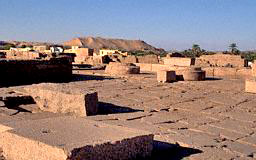
Ancient
ruins at Abu Island, |
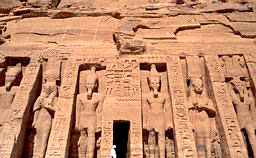
(Elephantine
today) |
|
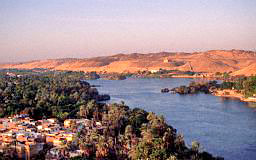
Site of
First Cataract, Nile River. |
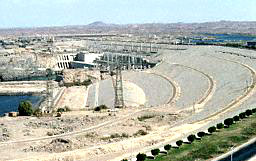
Aswan High
Dam.... regulating the Nileís waters.... just like Ptah/Enki
did.... |
|
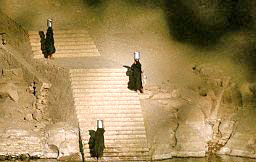
Women
carrying water from the Nile to their villages.
|
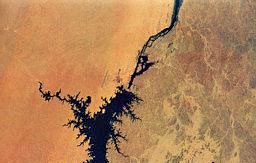
Aswan Dam
seen from Space. |
"According to this text
(continuing with Josephís events, as per the Egyptian account), the
Pharaoh Zoser (builder of the step-pyramid at Saqqara) received a
royal dispatch from the governor of the people of the south that
grievous suffering had come upon the people "because the Nile hath
not come forth to the proper heigth for seven years." As a result,
"grain is very scarce, vegetables are lacking altogether, every kind
of thing which men eat for their food hath ceased, and every man now
plondereth his neighbor."
"Hoping that the spread of famine and chaos could be avoided by a
direct appeal to the god, the king traveled south to the island of
Abu. The god, he was told, dwells there "in an edifice of wood with
portals formed of reeds," keeping with him "the cord of the tablet"
that enable him to "open the double door of the sluices of the
Nile." Khnemu, responding to the kingís pleadings, promised "to
raise the level of the Nile, give water, make the crops grow."
"Since the annual rising of the Nile was linked to the
heliacal
rising of the star Sirius, one must wonder whether the taleís
celestial or astronomical aspects recall not only the actual
shortage of water (which occur cyclically even nowadays) but also
the shift.... in the appearance of Sirius under a rigid calendar.
That the whole tale had calendrical connotations is suggested by the
statement in the text that the abode of Khnemu at Abu was
astronomically oriented:
"The godís house hath an opening to the
southeast, and the Sun standeth immediately opposite thereto every
day."
This can only mean a facility for observing the Sun in the
course of moving to and from the winter solstice.
"This brief review of the use and significance of the number seven
in the affairs of gods and men suffices to show its celestial origin
(the seven planets from Pluto to Earth) and its
calendrical
importance (the seven-day week, a year of fifty-two such weeks). But
in the rivalry among the Anunnaki, all that assumed another
significance: the determination of who was the God of Seven (Eli-Sheva
in Hebrew, from which Elizabeth comes) and thus the titular
Ruler of
Earth.
"And that we believe, is what alarmed Ra/Marduk on his return to
Egypt after his failed coup in Babylon: the spreading
veneration of
Seven, still Enlilís epithet, through the introduction of the
seven-day week into Egypt.
"In these circumstances the veneration of the
Seven Hathors, as an
example, must have been anathema to Ra/Marduk.
"....Since the official spouses of both (Ninki of
Enki, Ninlil of
Enlil) were not their half sisters, it was important for them to
beget a son by Ninharsag (their half sister): such a son under the
succession rules of the Anunnaki, would be the undisputed
Legal Heir
to the throne on Earth.... Ninharsag only bore daughters to
Enki....
but Enlil was more successful and his Foremost Son was
conceived....This entitled Ninurta (Ningirsu, the "Lord of Girsu" to
Gudea) to inherit his fatherís rank of fifty - at the same time
depriving Enkiís firstborn, Marduk, of rulership over the Earth.
"...Archaeologists have discovered in the area of
Saqqara (of the
times of Zoser), a circular "altar top" of alabaster whose shape
suggests that it was intended to serve as a sacred lamp to be
lighted over a seven-day period. Another find is that of a stone
"wheel" (some think it was the base of an omphalos, an oracular
"navel stone") that is clearly divided into four segments of seven
markers each, suggesting that it was really a stone calendar - a
lunar calendar, no doubt - incorporating the seven-day week concept
and (with the aid of the four dividers) enabling a lunar monthly
count ranging from twenty-eight to thirty-two days.... It is our
belief that the genius behind all of those geographically
(Stonehenge in Britain; Aztec calendar in Mexico) spread
stone
calendars was one and the same god: Thoth.
"....What archaeologists identify as games or game boards have been
found almost everywhere in the ancient Near East.... Mesopotamia,
Canaan, and Egypt.... Two players moved pegs from one hole to
another in accordance with the throw of dice. Archaeologists see in
that no more than games with which to while away the time; but the
usual number of holes, fifty-eight, is clearly an allocation of
twenty-nine to each player - and twenty-nine is the number of full
days in a lunar month. There were also obvious subdivisions of the
holes into smaller groups, and grooves connected some holes to
others (indicating perhaps that the player could jump-advance
there)....
"....Nowadays we employ ditties ("Thirty days hath September") and
games to teach the modern calendar to children; why exclude the
possibility that it was so also in antiquity?
"That these were
calendar games and that at least one of them, the
favorite of Thoth, was designed to teach the division of the year
into fifty-two weeks, is evident from an ancient Egyptian tale known
as "The Adventures of Satni-Khamois with the Mummies."
"It is a tale of magic, mystery, and adventure, an ancient thriller
that combines the magical number fifty-two with Thoth and the
secrets of the calendar. The tale is written on a papyrus
(catalogued as Cairo-30646) that was discovered in a tomb at
Thebes,
dating to the third century B.C. Fragments of other papyruses with
the same tale have also been found, indicating that it was part of
the established or canonical literature of ancient Egypt that
recorded the tales of gods and men.
"The hero of this tale was
Satni, a son of the pharaoh, "well
instructed in all things." He was wont to wonder in the necropolis
of Memphis.... One day a mysterious old man told him of a tomb
"where there is deposited the book that the god Thoth had written
with his own hands," and in which the mysteries of the Earth and the
secrets of heaven were revealed....
It was a challenging fate for
Satni, as he tried to retrieve the
book and face the wrath of Thoth....
"....How Satni managed to escape with the book, the calamities that
befell him as a result, and how he in the end returned the book to
its hiding place, makes fascinating reading but is unessential to
our immediate subject: the fact that the astronomical and
calendrical "secrets of Thoth" included the Game of Fifty-Two - the
division of the year into fifty-two seven day portions, resulting in
the enigmatic year of only 364 days of the books of Jubilees and
Enoch.
"It is a magical number that vaults us across the oceans, to the
Americas, returns us to the enigma of Stonehenge, and parts the
curtains on the events leading to, and resulting from, the first New
Age recorded by Mankind.
Return
|








